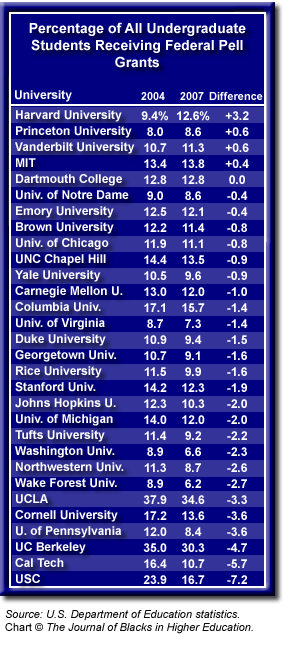



High-Ranking Universities Are Not Making Much Progress in Increasing Their Enrollments of Low-Income Students
Ten years ago Princeton University revolutionized the college financial aid world when it decided to provide full-tuition scholarship grants for all students from families with incomes below $40,000 a year. Princeton soon afterward eliminated loans for all students on financial aid and replaced these loans with scholarship grants.
Over the next several years, Harvard, the University of Virginia, and the University of North Carolina at Chapel Hill eliminated student loans and/or greatly increased their financial aid packages for low-income students.
Over the past three years most of the other highly rated universities have made huge changes to their financial aid programs in order to keep pace with the leaders’ efforts to attract more low-income students.
But data obtained by JBHE from the U.S. Department of Education on recipients of Pell Grants at these high-ranking universities show that most of these educational institutions have not been successful in increasing the socioeconomic diversity of their student bodies. (Pell Grants are reserved for students who come from families with low incomes.) In fact, in the vast majority of cases, there is a smaller percentage of low-income students at these institutions than before the new financial aid programs were put into effect.

According to Pell Grant data, only four of the nation’s 30 highest-ranked universities had a larger percentage of low-income students in 2007 than was the case three years earlier in 2004. They are Harvard University, Princeton University, Vanderbilt University, and MIT. At Dartmouth College, the percentage of low-income students remained the same. But at 25 of the 30 highest-ranked universities, the percentage of the student body that came from low-income families declined from 2004 to 2007. And again, this was in a period when these universities had revamped their financial aid programs to make them more attractive to low-income students.
One of the main reasons for this trend is that these universities also made generous financial aid changes to help middle- and upper-middle-income students. For example, at Harvard, students who come from a family with an annual income of $180,000 are expected to pay only $18,000 of Harvard’s $50,000 annual comprehensive fee. At Yale, students from families with incomes of more than $200,000 are eligible for “need-based” financial aid. So more students from these upper-middle-income families are applying to these universities and these students tend to have better test scores and grades than students from low-income families.
The new financial aid packages targeting low-income students did nothing to increase the chances of these students gaining admission to these universities.

Note: Next week JBHE will report the progress of the nation’s leading liberal arts colleges in increasing the socioeconomic diversity of their campuses.
![]()
Copyright © 2008. The Journal of Blacks in Higher Education. All rights reserved.